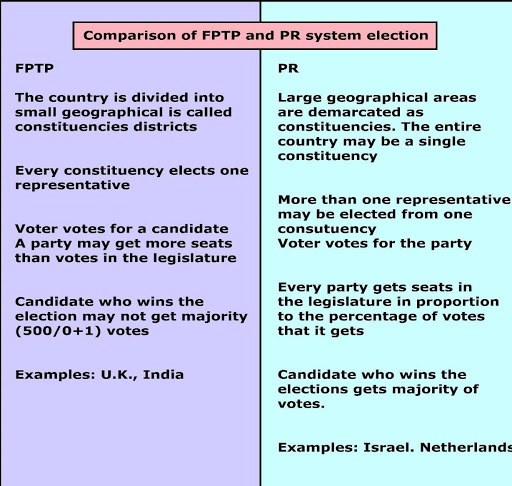Election System in India
- An election is a formal collective decision-making process in which the population of a country chooses one or more people to occupy public office
- The electoral system, on the other hand, often known as a voting system, is a collection of laws that govern how elections and referendums are held and how their outcomes are decided
- In a democratic election, people vote, and their preference decides who will win the contest. Some rules can favour the majority community, while others can protect the minorities.
First Past the Post System
- The entire country is divided into 543 constituencies
- Each constituency elects one representative
- The candidate who secures the highest number of votes in that constituency is declared elected
- No need of majority of votes: In this system, whoever has more votes than all other candidates, is declared elected. This method is called the First Past the Post (FPTP) system
- This method is also called the Plurality System
- This is the method of election prescribed by the Constitution.
Check out the complete UPSC Syllabus
Proportional Representation (PR)
- Proportional Representation is a voting method used in elections that allows parties to receive seats in proportion to the number of votes cast for them
- In some countries like Israel or Netherlands, the entire country is treated as one constituency and seats are allocated to each party according to its share of votes in the national election
- In some countries like Argentina and Portugal, the country is divided into several multi-member constituencies. Each party prepares a list of candidates for each constituency, depending on how many have to be elected from that constituency
- In both cases, voters exercise their preference for a party and not a candidate. The seats in a constituency are distributed based on votes polled by a party. Along these lines, agents from supporters, would and do have a place with various gatherings.
- India has taken on a Proportional Representation framework on a restricted scale for circuitous decisions. The Constitution endorses a third and complex variety of the Proportional Representation framework for the appointment of President, Vice President, and for the political race to the Rajya Sabha and Vidhan Parishads.
Visit to know more about UPSC Exam Pattern
Proportional Representation(PR) system in Rajya Sabha elections:
- It follows a third variant of PR- the Single Transferable Vote system (STV)
- Every State has a specific quota of seats in the Rajya Sabha
- The members are elected by the respective State legislative assemblies
- The voters are the MLAs in that State
- Every voter is required to rank candidates according to her or his preference
- To be declared the winner, a candidate must secure a minimum quota of votes, which is determined by a formula:

- Votes are counted based on first preference votes secured by each candidate, i.e., of which the candidate has secured the first preference votes
- If after the counting of all first preference votes, the required number of candidates fail to fulfil the quota, the candidate who secured the lowest votes of first preference is eliminated and his/her votes are transferred to those who are mentioned as second preference on those ballot papers. This process continues till the required number of candidates are declared elected
Comparison of FPTP and PR System of Election

Election and Democracy
- In a Democracy, people participate in the electoral process and directly choose their representatives. Our Constitution lays down some rules to ensure free and fair elections
- The essence of democracy is that elected leaders are responsible to the public and must return to the voters at predetermined intervals to seek re-election. As a result, most democratic constitutions require elections to be conducted at regular intervals.
Also read UPSC Notes
Direct democracy
- It is one where the citizens directly participate in the day-to-day decision-making and in the running of the government such as the ancient city-states in Greece
Indirect democracy
- Necessity of representation in a large democracy: All citizens cannot take direct part in making every decision. Rule by the people usually means rule by people’s representatives
- In such an arrangement, citizens choose their representatives who are actively involved in governing and administering the country
- The method followed to choose these representatives is referred to as an election
- Role of citizens:
- Not actively involved: They have a limited role in taking major decisions and in running the administration
- Citizens are involved indirectly through their elected representatives
Role of Constitution
- It lays down some basic rules about elections for ensuring free and fair elections
- These basic rules are usually about eligibility to vote, to contest, supervision of elections etc
Conclusion
We have looked into elections and the election systems, highlighting our country India in this chapter. We can conclude by stating that Election is a method or procedure used by many nations to allow citizens to pick their representative. We also looked at the lok sabha and the rajya sabha. While the Lok Sabha, is the legislative assembly in which the people elect their members. The MPs in Rajya Sabha are elected by the elected members of the State Assemblies. Moreover, The Rajya Sabha is a permanent body, while the Lok Sabha is dissolved every five years.
 Profile
Profile Settings
Settings Refer your friends
Refer your friends Sign out
Sign out













